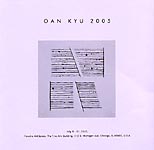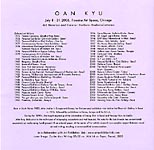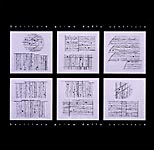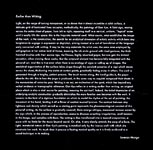


| Oan Kyu Earlier than Writing | ||||
 | ||||
 |
 |
 |
||
 |
||||
 | ||||
 | ||||
 | ||||
 |
 |
 |
||
 |
||||
 | ||||
 | ||||
 | ||||
|
Exhibition Statement
Calligraphy – An Expression of Body and Mind Technically there is no mystery in Asian calligraphy. The tools for Asian calligraphy are very few – good ink, an inkstone, a good brush and good paper. However, to create a harmonious whole out of dots and lines in a well balanced space depends on a great artistic insight and highly technical skills. Calligraphy is spiritual and bodily at the same time. Western artists were greatly influenced by Asian calligraphy and its characteristics to combine a spiritual and bodily effort to create a work of art. Above all the new dimension of space that is created between the internal and external, a meditative space, with which the artist can intuitively identify himself, greatly influenced the American and European artists of the 20th century. The American artists Basquiat, Cage, Motherwell, Newman, Pollock, Rothko and Twombly and the European artists Brancuse, Kandinsky, Klee, Malewitsch, Marc, Miro, Polke, Schwitter, to name just a few, who viewed their work primarily as a quest for self-discovery, applied calligraphy and gesture in their pictorial statements. Amal Ghosh compares Jackson Pollock's (20th century) statement on the automatism in his action paintings, "when I am painting, I am not aware of what I am doing and the painting comes out well" with the statement of the Zen artist Wen T-ung (10th century), "at the beginning, I saw the bamboo and delighted in it, now I delight in it and lose consciousness of myself. Suddenly I forget that the brush is in my hand, the paper in front of me all at once I am exhilarated and the tall bamboo appears thick and luxuriant." Two artists from different cultures and centuries create an East-West connection by abandoning themselves in their artwork to the unconscious. It is the suspension of consciousness of the human mind that Oan Kyu, Korean artist living in Rome, exercises in her calligraphical composition in order to perceive a higher dimension of the "self." Oan's work is a quest for self-discovery written in a state of "mood." Mood is understood in the ontological sense. "Mood" writes Heidegger, "is never a way of being attuned, and letting ourselves be attuned in this or that way in mood. Mood is precisely the basic way in which we are outside ourselves. But that is the way we are essentially and constantly." The calligraphical compositions which Oan Kyu entitles "Diary" or "Earlier than Writing" have the same creative process many of the 20th century artists used, which although "unique to each individual, invariably seemed to involve a detachment from "self and involvement with or perception of'other'." (A.G.) Oan Kyu is firmly rooted in the tradition of calligraphers of her native country. The same technique, the same tools – ink, inkstone, brush and paper – to achieve a pictorial "automatism" based on perception, on intuition and on the unconscious to perceive, to use again a term from ontology, the forces of intentionality, which are at the very base of our Being and which have to do with possibilities. The state of Being before the act of decision, before the concrete thought or word, before writing – hence the title "Earlier than Writing." Automatism here is understood as an instrument to add chance, spontaneity and flux to the artwork. However, the flow of ink in Oan's script, as the flow of paint in Pollock's action paintings, is ultimately controlled. Oan Kyu creates a pictorial equivalent of man's perception and intuition of his complex inner self. Lines and points do not form a static image but embody a vibration, an abstract and at the same time bodily composition which Lorenzo Mango in his essay that accompanies this exhibition compares appropriately with a musical composition, "a score with no limits of the music beyond sound." While Pollock's journey into the inner self is highly tormented, Oan Kyu's composition placed into a well-balanced space transmits an emotion of harmony achieved out of a state of meditation and tension. It is fascinating to discover the affinity between these two artists of the Modern Age as well as that of a Zen artist of the 10th century who express and make visible in their artwork the very essence of man and the "primordial relation, the belonging together of man and Being" – of body and mind.
Barbara Goebels-Cattaneo |
||||
 | ||||
 | ||||
 | ||||
|
Catalog Statement
Earlier than Writing Lorenzo Mango |
||||
 | ||||
 | ||||
 | ||||
| View the Work | ||||
 | ||||


